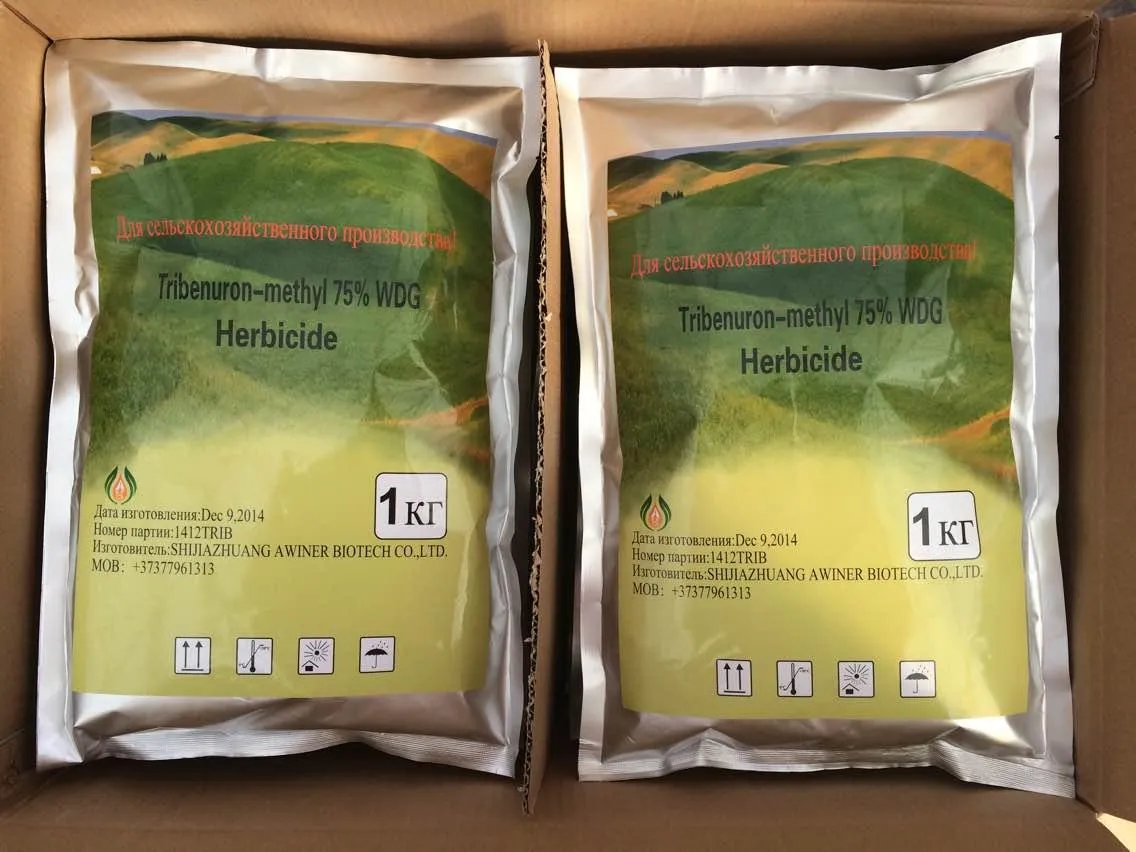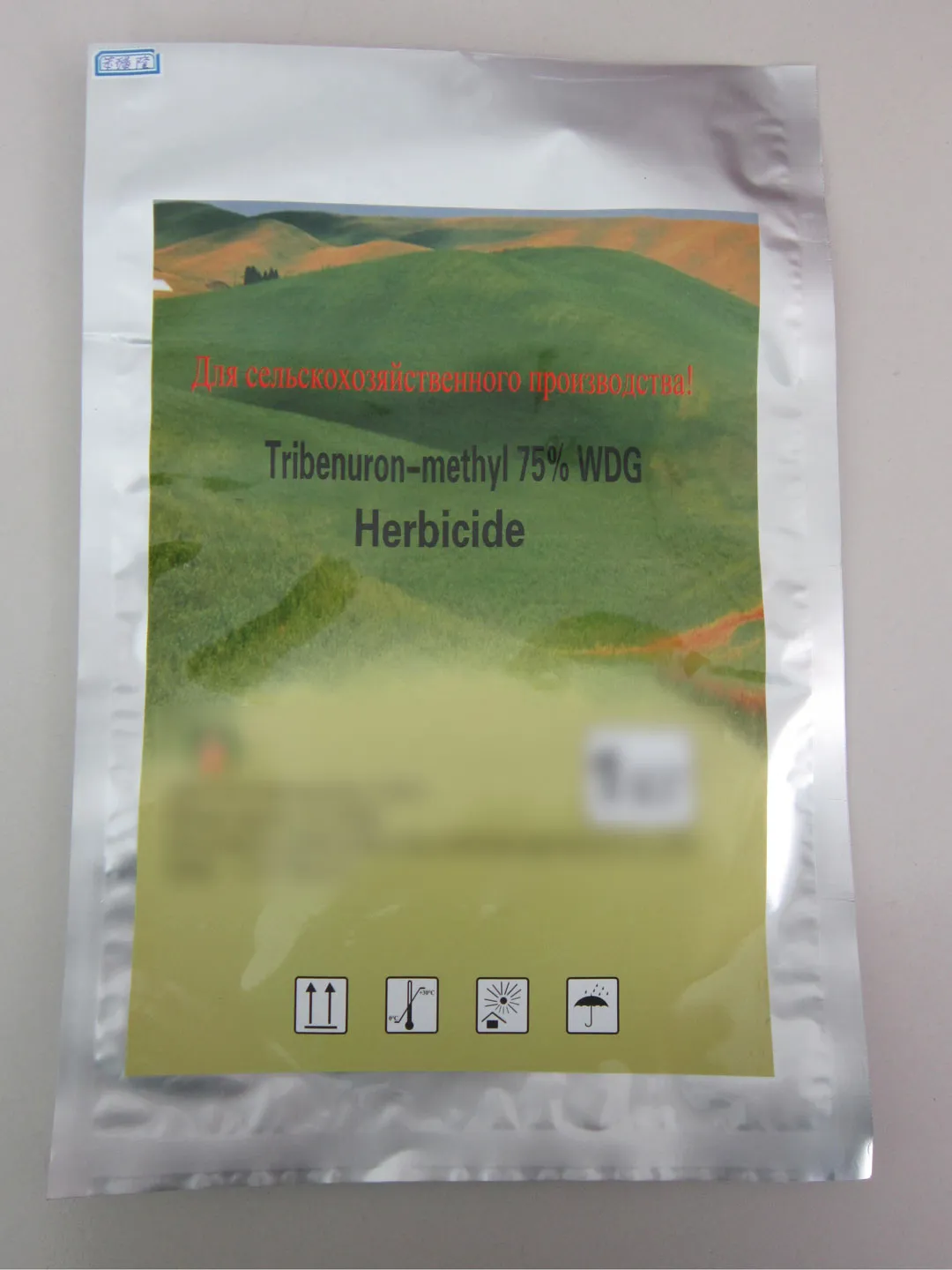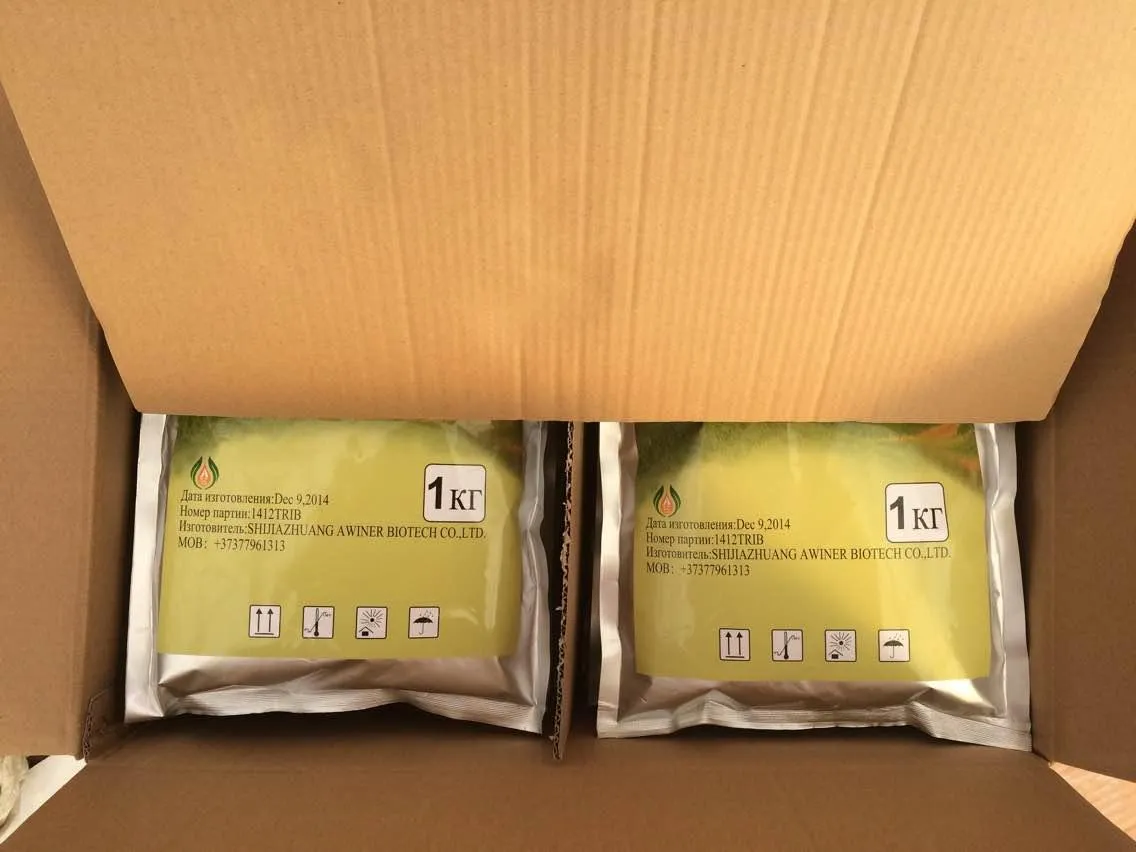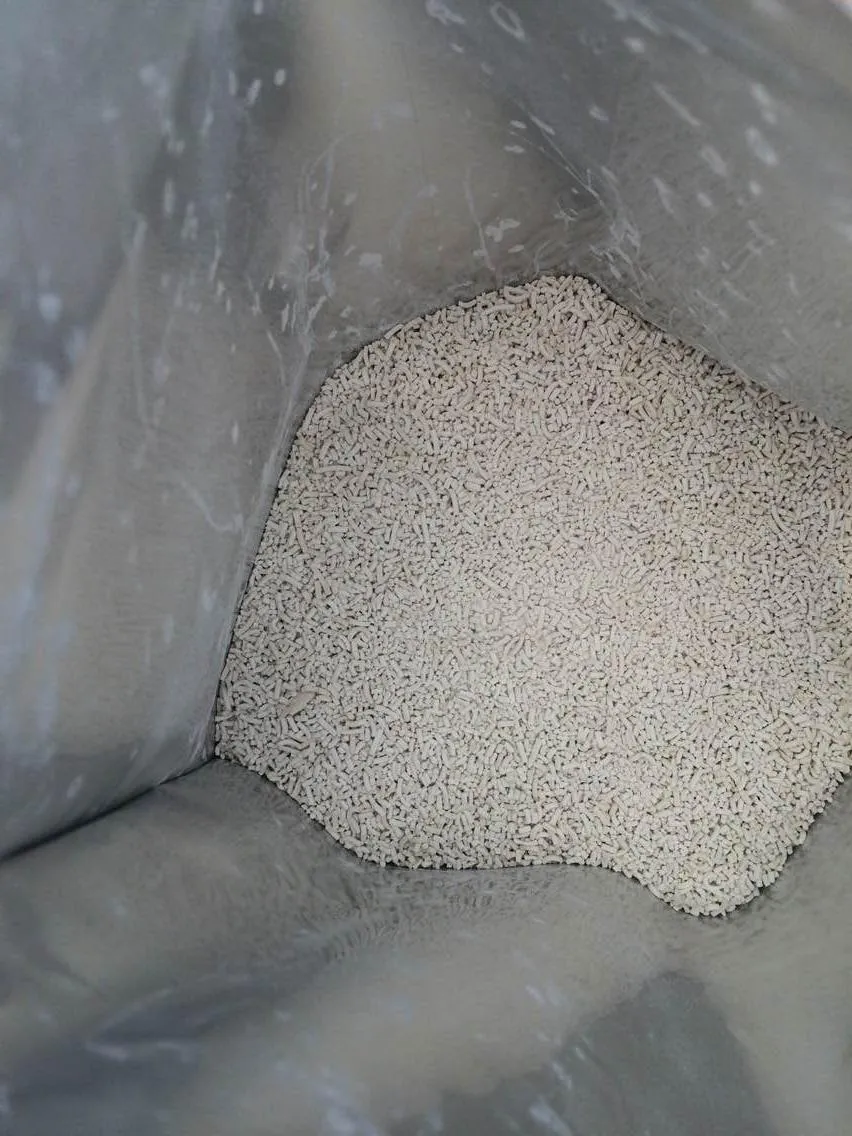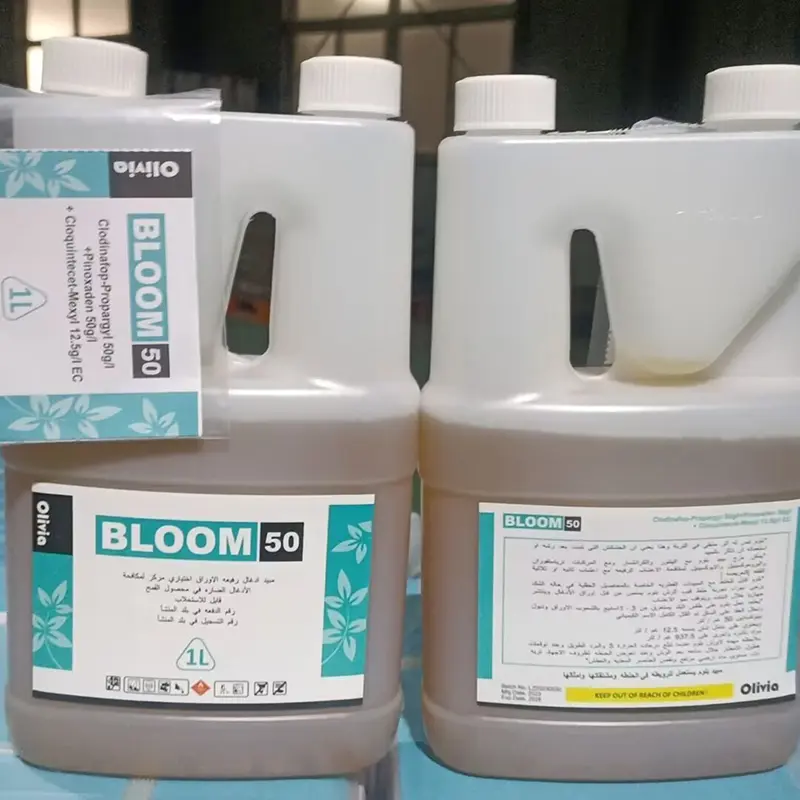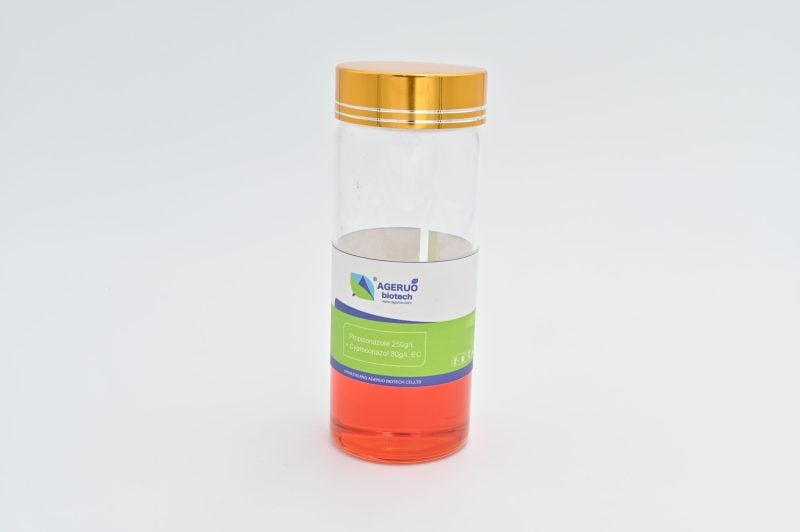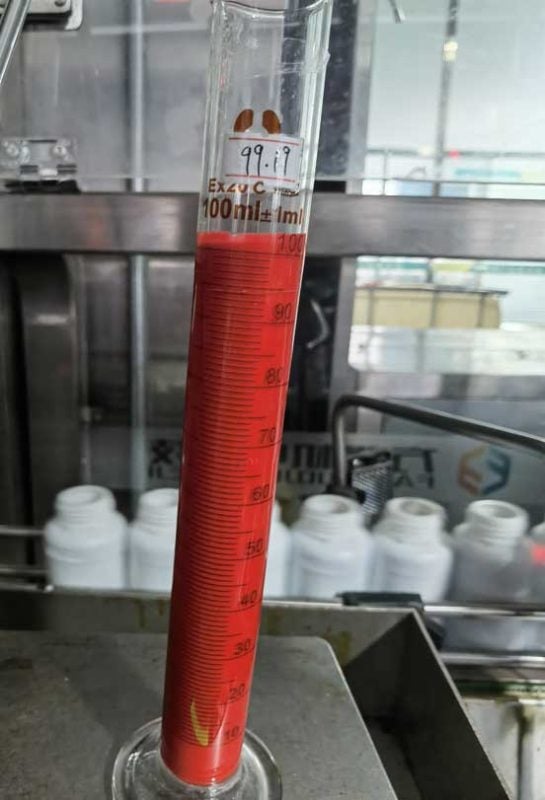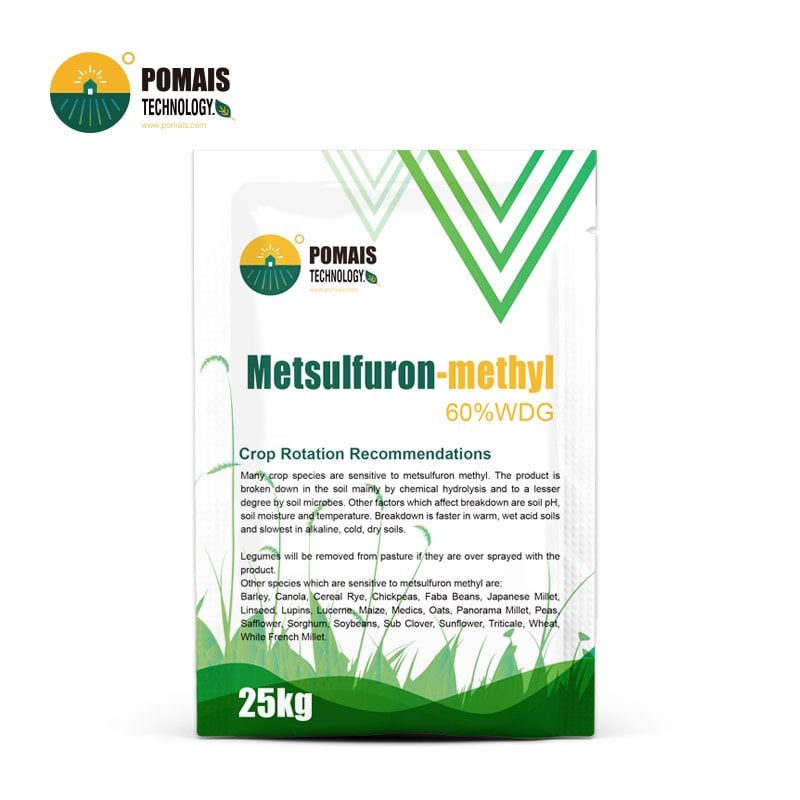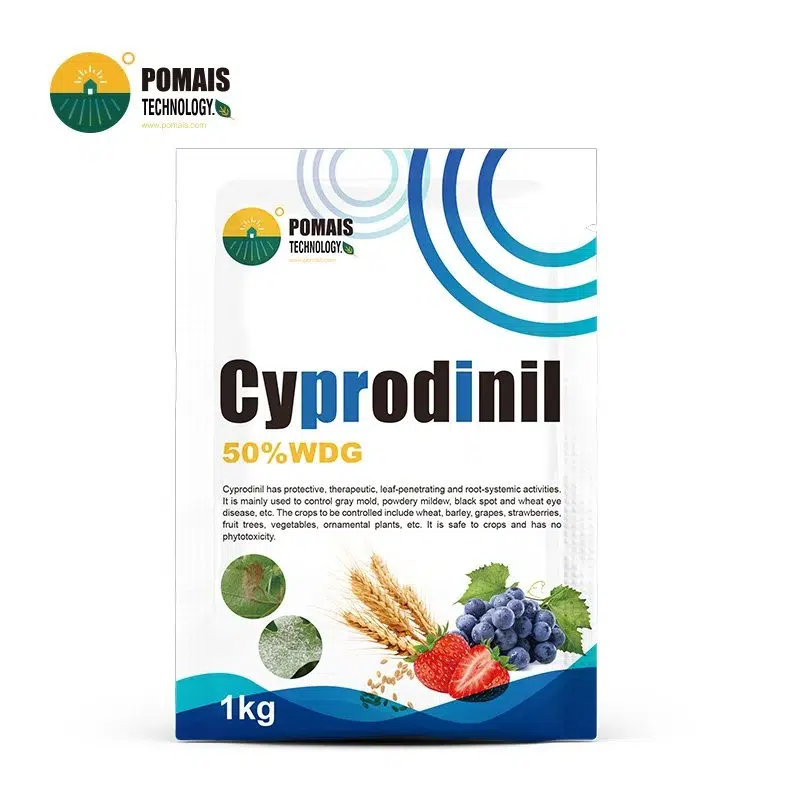Tribenuron-Methyl Herbicide
Selective Post-Emergence Control for Broadleaf Weeds
If you’re seeking a fast-acting, selective herbicide for broadleaf weed control in cereal crops, Tribenuron Methyl offers the performance and flexibility you need. This sulfonylurea-based herbicide is widely used in wheat, barley, oats, and other cereal systems due to its excellent post-emergent activity and minimal crop injury. It inhibits weed growth by disrupting amino acid synthesis in susceptible species, delivering visible results within days of application.
POMAIS supplies Tribenuron Methyl herbicide in a variety of formulations, such as 10% WP, 75% WG, and technical grade, with customized packaging and formulation support. Our products are designed to help you manage key weed species efficiently while complying with international quality and regulatory standards.
- Designed for Professional Buyers & Bulk Orders
- This product is available for business purchase and large-scale distribution.
- We support custom packaging, labeling, and formulation to meet your market needs.
- Let’s build your brand together.

About Tribenuron-Methyl Herbicide
About Tribenuron-Methyl Herbicide
| Product Name | Tribenuron-methyl Herbicide |
| Formulation Types | 75% WDG, 50% WP, 10% SC |
| Active Ingredient | Tribenuron-methyl |
| CAS Number | 101200-48-0 |
| Chemical Class | Sulfonylurea |
| Molecular Formula | C15H17N5O6S |
| Mode of Action | ALS inhibitor (blocks synthesis of branched-chain amino acids) |
| Target Weeds | Broadleaf weeds: chickweed, cleavers, wild mustard, shepherd’s purse, etc. |
| Target Crops | Wheat, barley, oat, rye, triticale |
| Recommended Rate | 10–150g/ha depending on formulation |
| Rainfastness | 4–6 hours after application |
| Soil Persistence | 5–20 days (low leaching and volatility) |
| Toxicology | Low toxicity to mammals, birds, and beneficial insects |
| Tank Mix Compatibility | Compatible with Metsulfuron, MCPA, 2,4-D, Glyphosate, etc. |
| Packaging Options | 500g–25kg bags, foil pouches, fiber drums |
| OEM Label Customization | Multilingual printing, crop imagery, safety icons |
| Formulation Adjustments | Moisture, dispersibility, wetting agents customizable |
| Documentation Support | COA, MSDS, TDS, FAO certificate, registration dossier |
| Production Standards | FAO-compliant manufacturing |
| Service Regions | Central Asia, Middle East, Africa, Latin America |
| MOQ & Lead Time | Flexible MOQ, fast sampling, export-ready packaging |
Tribenuron Methyl Herbicide – Selective Post-Emergence Control for Broadleaf Weeds
Tribenuron-methyl is a highly active sulfonylurea herbicide used primarily for post-emergence control of broadleaf weeds in cereal crops. It is classified as a systemic, selective herbicide, designed to inhibit the growth of sensitive weeds by interfering with their essential enzymatic pathways.
Belonging to the ALS (acetolactate synthase) inhibitor group, tribenuron-methyl disrupts the biosynthesis of branched-chain amino acids (valine, leucine, and isoleucine), which are crucial for cell division and growth. This leads to rapid inhibition of weed development shortly after application, typically with visible symptoms such as chlorosis and necrosis within 5 to 10 days.
It is widely recognized for its high efficacy at low use rates, rapid degradation in soil, and crop safety in cereals like wheat and barley. It also shows favorable environmental properties, including low volatility and reduced leaching potential under standard field conditions.
Mode of Action & Selectivity
Tribenuron-methyl works by inhibiting the enzyme acetolactate synthase (ALS), a key catalyst in the biosynthesis of branched-chain amino acids essential for plant cell division and growth. Once absorbed through the foliage, the active ingredient translocates via the phloem to meristematic tissues, where it effectively halts cell division in sensitive broadleaf weeds.
This systemic, post-emergence herbicide is remarkably selective due to its unique metabolic pathways in crops versus target weeds. Cereal crops such as wheat and barley can metabolize tribenuron-methyl quickly into non-toxic byproducts, while broadleaf weeds lack this capacity and are therefore highly susceptible.
Visible effects such as chlorosis and stunted growth typically appear within days, followed by necrosis and complete control within 1–3 weeks depending on weed species and environmental conditions.
Formulations & Technical Specifications
Tribenuron-methyl is available in versatile formulations to suit various crop protection programs, with technical specifications that meet international quality and registration standards.
The most commonly supplied forms include Tribenuron-methyl 75% WDG (water dispersible granules) and Tribenuron-methyl 10% WP (wettable powder). These formulations are designed for ease of use, rapid dispersion, and consistent field performance, making them ideal for both small-scale farms and large commercial operations.
The active ingredient has a CAS number of 101200-48-0, a molecular formula of C15H17N5O6S, and functions as a Group 2 ALS-inhibitor herbicide. It is characterized by low use rates (typically 15–30g/ha), which contribute to reduced packaging waste and favorable logistics.
All POMAIS products conform to FAO quality standards and can be produced with customizable moisture content, particle size, and wetting agents based on your market registration needs.
Target Weeds & Crops
Tribenuron-methyl delivers highly effective control of a wide range of broadleaf weeds while maintaining excellent crop selectivity in cereals and other rotational crops.
It is particularly effective against key weed species such as chickweed (Stellaria media), cleavers (Galium aparine), shepherd’s purse (Capsella bursa-pastoris), wild mustard (Sinapis arvensis), field pennycress (Thlaspi arvense), pigweed (Amaranthus spp.), henbit, and common lambsquarters (Chenopodium album). These are often troublesome in winter and spring cereals, especially in wheat, barley, and oats.
This herbicide is ideally suited for use in wheat, barley, oat, rye, and triticale, and its favorable rotational profile also supports follow-up crops such as corn, soybeans, potatoes, flax, and sunflower. Its ability to act early in the weed lifecycle helps minimize competition during critical crop growth stages, leading to better yield potential and cleaner fields.
By targeting broadleaf weeds at the cotyledon to 4-leaf stage, Tribenuron-methyl achieves rapid growth inhibition and visible symptoms like chlorosis and necrosis within days of application.
Application Methods & Dosage
Tribenuron-methyl is typically applied as a post-emergence foliar spray, allowing it to effectively target actively growing broadleaf weeds without harming cereal crops.
It is best used between the 2- to 6-leaf stage of the crop and when the target weeds are in the cotyledon to 4-leaf growth stages. Applying during optimal weed size maximizes uptake and translocation, ensuring strong herbicidal activity and minimal regrowth.
Recommended Application Rates:
| Formulation | Rate (per hectare) | Application Timing |
|---|---|---|
| Tribenuron-methyl 75% WDG | 10–15 g/ha | Post-emergence (weed 2–4 leaf stage) |
| Tribenuron-methyl 50% WP | 20–30 g/ha | Post-emergence |
| Tribenuron-methyl 10% SC | 100–150 ml/ha | Post-emergence |
Application Tips:
- Use a water volume of 200–400 L/ha, ensuring even coverage of weed foliage.
- Apply under calm wind conditions and avoid spraying before rain or irrigation within 4–6 hours after application.
- For dense weed populations, use the higher end of the recommended dosage range.
This flexibility in application enables Tribenuron-methyl to be tailored to local weed pressure, environmental conditions, and crop stage—enhancing its utility in diverse agricultural systems.
Rainfastness & Environmental Behavior
Tribenuron-methyl offers moderate rainfastness and exhibits environmentally favorable degradation characteristics, making it a reliable and responsible choice for sustainable weed control.
Rainfastness:
The herbicide becomes rainfast approximately 4–6 hours after application, depending on temperature and humidity. During this period, foliar absorption is mostly complete, ensuring efficacy even under light rainfall events post-application. For best results, avoid spraying if rain is forecast within 3 hours to prevent runoff and reduced effectiveness.
Degradation & Persistence:
Tribenuron-methyl is readily degraded in the environment via microbial activity and hydrolysis. It has a short soil half-life (typically 5–20 days), minimizing long-term soil residue and reducing the risk of carryover injury to subsequent crops. Its low vapor pressure and high soil adsorption characteristics further reduce leaching and volatilization potential.
Environmental Profile Highlights:
- Low toxicity to birds, mammals, and aquatic invertebrates
- Non-volatile, ensuring reduced off-target movement
- Safe for beneficial insects, including pollinators, when used as directed
- Does not bioaccumulate or persist in groundwater under standard use patterns
This favorable environmental behavior makes Tribenuron-methyl a suitable herbicide in modern, sustainability-conscious cropping systems and contributes to integrated weed management (IWM) programs without compromising ecosystem health.
Resistance Management & Mixing Compatibility
Tribenuron-methyl plays a vital role in herbicide resistance management strategies and offers excellent compatibility for tank mixing, broadening its utility across various integrated weed control programs.
Resistance Management Strategy
As a member of the ALS (acetolactate synthase) inhibitor herbicide group (HRAC Group 2), Tribenuron-methyl is vulnerable to resistance development in certain weed populations, particularly under continuous monoculture or repeated use. To delay resistance buildup:
- Rotate modes of action: Alternate with herbicides from different HRAC groups, especially those with contact or residual activity.
- Use full label rates: Underdosing can encourage the survival of resistant biotypes.
- Apply at early weed stages: Younger weeds are more susceptible, allowing for greater control and less selection pressure.
- Integrate cultural practices: Combine with mechanical weeding, crop rotation, and competitive crop canopies to reduce reliance on herbicides.
Mixing Compatibility & Tank Mixes
Tribenuron-methyl is highly compatible with many other herbicides, adjuvants, and foliar fertilizers, enabling it to be part of diverse tank-mix programs for broader-spectrum weed control. It is often combined with:
| Compatible Herbicides | Purpose |
|---|---|
| Metsulfuron-methyl | Enhanced broadleaf weed spectrum |
| 2,4-D Amine or Ester | Fast-acting broadleaf burn-down effect |
| MCPA | Synergistic control of key annual weeds |
| Glyphosate (in non-crop use) | Broad-spectrum knockdown on fallow land |
Mixing Guidelines:
- Always conduct a jar test before large-scale mixing to check for precipitation or layering.
- Follow the correct mixing order: water → wettable powders → SC/EC formulations → adjuvants → Tribenuron-methyl → foliar fertilizers.
- Use clean water and maintain continuous agitation during mixing and spraying.
By combining flexibility in mixing and a clear role in resistance delay programs, Tribenuron-methyl helps sustain long-term weed control effectiveness while supporting diversified field practices.
Packaging & OEM Customization
We provide flexible packaging options and OEM customization services to meet the unique needs of importers, distributors, and agrochemical brand owners across global markets.
Available Packaging Options
Tribenuron-methyl is typically offered in the following formulations and standard packing sizes:
| Formulation | Packaging Options |
|---|---|
| 75% WDG | 1kg, 5kg, 10kg, 25kg aluminum foil bags or fiber drums |
| 10% WP / 50% WP | 500g, 1kg, 25kg PP bags or craft paper sacks |
| Technical Grade | 25kg fiber drum or custom industrial bulk packaging |
All packaging materials are moisture-resistant and suitable for long-distance shipping and extended shelf life under proper storage conditions. We also offer custom secondary packaging (outer cartons, palletizing) for optimized handling and display.
OEM / Private Label Services
To support your branding and regulatory needs, POMAIS offers full-spectrum OEM and private label solutions:
- Custom label design: Language, crop photos, usage tables, safety icons
- Brand name printing: On both inner and outer packaging
- Formulation ratio adjustment: Based on your country’s registration or market demand
- Certificate preparation: COA, MSDS, TDS, FAO-compliance, and registration dossiers
We ensure all customized packaging complies with destination regulations, including barcoding, batch numbers, and expiry details. Whether you’re launching a new product line or expanding your portfolio, we help streamline the customization and supply process from formulation to final delivery.
Compliance & Safety Guidelines
Tribenuron-methyl is widely recognized for its favorable toxicological profile, and its usage is governed by strict regulatory frameworks to ensure safety for applicators, crops, and the environment.
Toxicological Classification and Safety Measures
Tribenuron-methyl is classified as a Group B sulfonylurea herbicide with low acute toxicity to humans and animals. However, it is essential to follow all recommended safety procedures:
- Personal Protection: Applicators should wear protective clothing, gloves, and eye protection when mixing and spraying the product.
- Re-entry Interval (REI): Avoid entering treated fields for 12–24 hours post-application, unless wearing protective equipment.
- Pre-Harvest Interval (PHI): Observe minimum waiting periods based on specific crop registrations, typically 7–21 days.
Environmental Considerations
This herbicide is not highly persistent in soil and is subject to microbial degradation. However, care must be taken to avoid contamination of aquatic environments:
- Do not spray near water sources, streams, or ponds.
- Apply only during calm weather to reduce the risk of drift.
- Rinse containers three times before disposal and do not reuse.
Regulatory Approvals and Documentation
POMAIS supports your product compliance needs with complete documentation packages:
- Certificate of Analysis (COA)
- Safety Data Sheet (SDS/MSDS)
- Technical Data Sheet (TDS)
- FAO Compliance Documents
- Country-Specific Registration Dossiers (on request)
We ensure all products meet FAO specifications and adhere to local regulations in target markets, whether for Europe, Africa, the Middle East, or Asia-Pacific countries.
Field Use Scenarios of Tribenuron-Methyl
Tribenuron-methyl demonstrates consistent weed control performance across a wide range of agricultural conditions, making it a go-to solution for various field scenarios globally.
Pre- and Early Post-Emergence Application
In cereal crops like wheat and barley, Tribenuron-methyl is typically applied from the 2-leaf stage of the crop up to the flag leaf stage. Early applications target broadleaf weeds before they outcompete the crop for nutrients, ensuring clean fields during critical growth stages.
Dryland & Rainfed Areas
Thanks to its low use rate and systemic action, Tribenuron-methyl is particularly suitable for dryland farming where rainfall is unpredictable. It delivers effective results even under moisture-limited conditions due to its foliar uptake and partial soil residual activity.
Cold Climate Compatibility
The herbicide performs well in temperate and cold regions, including Eastern Europe and Central Asia. Farmers report reliable weed suppression in early spring applications, even under cool temperatures where some other herbicides underperform.
Tank Mixes for Broader Control
In fields with a mixed population of broadleaf and grassy weeds, Tribenuron-methyl is often tank-mixed with graminicides such as fenoxaprop-P-ethyl or clodinafop-propargyl. This broadens the weed control spectrum while minimizing herbicide resistance development.
Crop Rotation Systems
Its short residual period makes Tribenuron-methyl ideal for crop rotation systems. It allows flexible planting of legumes, oilseeds, and other sensitive crops after a short interval without significant carryover risk.
Localized Spot Treatment
In high-value horticultural areas or low-infestation zones, Tribenuron-methyl can be applied as a spot treatment to eliminate persistent broadleaf weeds with minimal impact on surrounding plants.
FAQ – Tribenuron-Methyl Herbicide
Below are answers to common questions from users and buyers of Tribenuron-methyl herbicide. This section is designed to clarify usage concerns and support informed purchasing and application decisions.
Q1: What types of weeds does Tribenuron-methyl control?
A: Tribenuron-methyl effectively controls a broad spectrum of broadleaf weeds, including sowthistle, chickweed, pigweed, cleavers, shepherd’s purse, and wild mustard. It is particularly useful in cereal crops like wheat and barley.
Q2: Can Tribenuron-methyl be used in combination with other herbicides?
A: Yes. It is commonly tank-mixed with graminicides (e.g., clodinafop, fenoxaprop) to extend its control to grassy weeds. However, always perform a compatibility test before large-scale mixing and consult local guidelines for resistance management.
Q3: Is Tribenuron-methyl suitable for use in dry climates?
A: Absolutely. Thanks to its low application rate and systemic activity, Tribenuron-methyl performs well in dryland conditions, especially when applied early to actively growing weeds.
Q4: How long does it take for weeds to die after application?
A: Weed symptoms typically appear within 5–10 days, with complete control achieved within 2–3 weeks depending on environmental conditions and weed species.
Q5: What is the replant interval after using Tribenuron-methyl?
A: Most crops, including corn and soybeans, can be replanted after 60–90 days. Sensitive crops like sugar beet or sunflowers may require longer intervals. Always refer to the label and local regulations.
Q6: Is Tribenuron-methyl harmful to bees or beneficial insects?
A: It poses minimal risk to bees and most beneficial insects when applied according to label instructions. Avoid spraying during pollinator activity to further minimize any ecological impact.
Why Choose POMAIS as Your Tribenuron-Methyl Supplier
POMAIS provides a reliable and customizable supply of Tribenuron-methyl herbicides, backed by manufacturing expertise, international registration support, and responsive service for global buyers.
As a professional agrochemical manufacturer based in China, we offer a full portfolio of Tribenuron-methyl formulations, including 75% WG, 10% WP, and premix combinations, tailored to meet different crop systems and regional weed spectrums. Our products are widely adopted by importers, distributors, and crop protection brands across Central Asia, the Middle East, Africa, and Latin America.
From formulation R&D to custom packaging and label design, we deliver a full-service OEM/ODM solution that helps you quickly enter the market or expand your portfolio. With stable raw material supply chains, advanced production facilities, and strict quality control systems, we ensure consistency in every batch shipped.
Additionally, we support pesticide registration dossiers and provide detailed technical documents, helping our partners shorten product approval timelines in their local markets. Whether you’re looking for cost-effective formulations or high-purity actives for premium markets, POMAIS adapts to your goals.
Start Your Partnership with POMAIS Today
Looking for a trusted supplier of Tribenuron-methyl herbicides with strong customization, consistent quality, and professional support? POMAIS is ready to help you grow your crop protection business with proven formulations and full-service OEM options.
Whether you’re launching a new brand, expanding your current product line, or seeking a reliable long-term manufacturing partner, our team can guide you from technical selection to final shipment. We offer flexible packaging sizes, multilingual labels, fast sampling, and dedicated export documentation support to ensure a seamless sourcing experience.
Reach out to us now to request a quote, product catalogue, or free sample. Let’s build a solution tailored to your market.
| Product Name | Tribenuron-methyl Herbicide |
| Formulation Types | 75% WDG, 50% WP, 10% SC |
| Active Ingredient | Tribenuron-methyl |
| CAS Number | 101200-48-0 |
| Chemical Class | Sulfonylurea |
| Molecular Formula | C15H17N5O6S |
| Mode of Action | ALS inhibitor (blocks synthesis of branched-chain amino acids) |
| Target Weeds | Broadleaf weeds: chickweed, cleavers, wild mustard, shepherd’s purse, etc. |
| Target Crops | Wheat, barley, oat, rye, triticale |
| Recommended Rate | 10–150g/ha depending on formulation |
| Rainfastness | 4–6 hours after application |
| Soil Persistence | 5–20 days (low leaching and volatility) |
| Toxicology | Low toxicity to mammals, birds, and beneficial insects |
| Tank Mix Compatibility | Compatible with Metsulfuron, MCPA, 2,4-D, Glyphosate, etc. |
| Packaging Options | 500g–25kg bags, foil pouches, fiber drums |
| OEM Label Customization | Multilingual printing, crop imagery, safety icons |
| Formulation Adjustments | Moisture, dispersibility, wetting agents customizable |
| Documentation Support | COA, MSDS, TDS, FAO certificate, registration dossier |
| Production Standards | FAO-compliant manufacturing |
| Service Regions | Central Asia, Middle East, Africa, Latin America |
| MOQ & Lead Time | Flexible MOQ, fast sampling, export-ready packaging |
Tribenuron Methyl Herbicide – Selective Post-Emergence Control for Broadleaf Weeds
Tribenuron-methyl is a highly active sulfonylurea herbicide used primarily for post-emergence control of broadleaf weeds in cereal crops. It is classified as a systemic, selective herbicide, designed to inhibit the growth of sensitive weeds by interfering with their essential enzymatic pathways.
Belonging to the ALS (acetolactate synthase) inhibitor group, tribenuron-methyl disrupts the biosynthesis of branched-chain amino acids (valine, leucine, and isoleucine), which are crucial for cell division and growth. This leads to rapid inhibition of weed development shortly after application, typically with visible symptoms such as chlorosis and necrosis within 5 to 10 days.
It is widely recognized for its high efficacy at low use rates, rapid degradation in soil, and crop safety in cereals like wheat and barley. It also shows favorable environmental properties, including low volatility and reduced leaching potential under standard field conditions.
Mode of Action & Selectivity
Tribenuron-methyl works by inhibiting the enzyme acetolactate synthase (ALS), a key catalyst in the biosynthesis of branched-chain amino acids essential for plant cell division and growth. Once absorbed through the foliage, the active ingredient translocates via the phloem to meristematic tissues, where it effectively halts cell division in sensitive broadleaf weeds.
This systemic, post-emergence herbicide is remarkably selective due to its unique metabolic pathways in crops versus target weeds. Cereal crops such as wheat and barley can metabolize tribenuron-methyl quickly into non-toxic byproducts, while broadleaf weeds lack this capacity and are therefore highly susceptible.
Visible effects such as chlorosis and stunted growth typically appear within days, followed by necrosis and complete control within 1–3 weeks depending on weed species and environmental conditions.
Formulations & Technical Specifications
Tribenuron-methyl is available in versatile formulations to suit various crop protection programs, with technical specifications that meet international quality and registration standards.
The most commonly supplied forms include Tribenuron-methyl 75% WDG (water dispersible granules) and Tribenuron-methyl 10% WP (wettable powder). These formulations are designed for ease of use, rapid dispersion, and consistent field performance, making them ideal for both small-scale farms and large commercial operations.
The active ingredient has a CAS number of 101200-48-0, a molecular formula of C15H17N5O6S, and functions as a Group 2 ALS-inhibitor herbicide. It is characterized by low use rates (typically 15–30g/ha), which contribute to reduced packaging waste and favorable logistics.
All POMAIS products conform to FAO quality standards and can be produced with customizable moisture content, particle size, and wetting agents based on your market registration needs.
Target Weeds & Crops
Tribenuron-methyl delivers highly effective control of a wide range of broadleaf weeds while maintaining excellent crop selectivity in cereals and other rotational crops.
It is particularly effective against key weed species such as chickweed (Stellaria media), cleavers (Galium aparine), shepherd’s purse (Capsella bursa-pastoris), wild mustard (Sinapis arvensis), field pennycress (Thlaspi arvense), pigweed (Amaranthus spp.), henbit, and common lambsquarters (Chenopodium album). These are often troublesome in winter and spring cereals, especially in wheat, barley, and oats.
This herbicide is ideally suited for use in wheat, barley, oat, rye, and triticale, and its favorable rotational profile also supports follow-up crops such as corn, soybeans, potatoes, flax, and sunflower. Its ability to act early in the weed lifecycle helps minimize competition during critical crop growth stages, leading to better yield potential and cleaner fields.
By targeting broadleaf weeds at the cotyledon to 4-leaf stage, Tribenuron-methyl achieves rapid growth inhibition and visible symptoms like chlorosis and necrosis within days of application.
Application Methods & Dosage
Tribenuron-methyl is typically applied as a post-emergence foliar spray, allowing it to effectively target actively growing broadleaf weeds without harming cereal crops.
It is best used between the 2- to 6-leaf stage of the crop and when the target weeds are in the cotyledon to 4-leaf growth stages. Applying during optimal weed size maximizes uptake and translocation, ensuring strong herbicidal activity and minimal regrowth.
Recommended Application Rates:
| Formulation | Rate (per hectare) | Application Timing |
|---|---|---|
| Tribenuron-methyl 75% WDG | 10–15 g/ha | Post-emergence (weed 2–4 leaf stage) |
| Tribenuron-methyl 50% WP | 20–30 g/ha | Post-emergence |
| Tribenuron-methyl 10% SC | 100–150 ml/ha | Post-emergence |
Application Tips:
- Use a water volume of 200–400 L/ha, ensuring even coverage of weed foliage.
- Apply under calm wind conditions and avoid spraying before rain or irrigation within 4–6 hours after application.
- For dense weed populations, use the higher end of the recommended dosage range.
This flexibility in application enables Tribenuron-methyl to be tailored to local weed pressure, environmental conditions, and crop stage—enhancing its utility in diverse agricultural systems.
Rainfastness & Environmental Behavior
Tribenuron-methyl offers moderate rainfastness and exhibits environmentally favorable degradation characteristics, making it a reliable and responsible choice for sustainable weed control.
Rainfastness:
The herbicide becomes rainfast approximately 4–6 hours after application, depending on temperature and humidity. During this period, foliar absorption is mostly complete, ensuring efficacy even under light rainfall events post-application. For best results, avoid spraying if rain is forecast within 3 hours to prevent runoff and reduced effectiveness.
Degradation & Persistence:
Tribenuron-methyl is readily degraded in the environment via microbial activity and hydrolysis. It has a short soil half-life (typically 5–20 days), minimizing long-term soil residue and reducing the risk of carryover injury to subsequent crops. Its low vapor pressure and high soil adsorption characteristics further reduce leaching and volatilization potential.
Environmental Profile Highlights:
- Low toxicity to birds, mammals, and aquatic invertebrates
- Non-volatile, ensuring reduced off-target movement
- Safe for beneficial insects, including pollinators, when used as directed
- Does not bioaccumulate or persist in groundwater under standard use patterns
This favorable environmental behavior makes Tribenuron-methyl a suitable herbicide in modern, sustainability-conscious cropping systems and contributes to integrated weed management (IWM) programs without compromising ecosystem health.
Resistance Management & Mixing Compatibility
Tribenuron-methyl plays a vital role in herbicide resistance management strategies and offers excellent compatibility for tank mixing, broadening its utility across various integrated weed control programs.
Resistance Management Strategy
As a member of the ALS (acetolactate synthase) inhibitor herbicide group (HRAC Group 2), Tribenuron-methyl is vulnerable to resistance development in certain weed populations, particularly under continuous monoculture or repeated use. To delay resistance buildup:
- Rotate modes of action: Alternate with herbicides from different HRAC groups, especially those with contact or residual activity.
- Use full label rates: Underdosing can encourage the survival of resistant biotypes.
- Apply at early weed stages: Younger weeds are more susceptible, allowing for greater control and less selection pressure.
- Integrate cultural practices: Combine with mechanical weeding, crop rotation, and competitive crop canopies to reduce reliance on herbicides.
Mixing Compatibility & Tank Mixes
Tribenuron-methyl is highly compatible with many other herbicides, adjuvants, and foliar fertilizers, enabling it to be part of diverse tank-mix programs for broader-spectrum weed control. It is often combined with:
| Compatible Herbicides | Purpose |
|---|---|
| Metsulfuron-methyl | Enhanced broadleaf weed spectrum |
| 2,4-D Amine or Ester | Fast-acting broadleaf burn-down effect |
| MCPA | Synergistic control of key annual weeds |
| Glyphosate (in non-crop use) | Broad-spectrum knockdown on fallow land |
Mixing Guidelines:
- Always conduct a jar test before large-scale mixing to check for precipitation or layering.
- Follow the correct mixing order: water → wettable powders → SC/EC formulations → adjuvants → Tribenuron-methyl → foliar fertilizers.
- Use clean water and maintain continuous agitation during mixing and spraying.
By combining flexibility in mixing and a clear role in resistance delay programs, Tribenuron-methyl helps sustain long-term weed control effectiveness while supporting diversified field practices.
Packaging & OEM Customization
We provide flexible packaging options and OEM customization services to meet the unique needs of importers, distributors, and agrochemical brand owners across global markets.
Available Packaging Options
Tribenuron-methyl is typically offered in the following formulations and standard packing sizes:
| Formulation | Packaging Options |
|---|---|
| 75% WDG | 1kg, 5kg, 10kg, 25kg aluminum foil bags or fiber drums |
| 10% WP / 50% WP | 500g, 1kg, 25kg PP bags or craft paper sacks |
| Technical Grade | 25kg fiber drum or custom industrial bulk packaging |
All packaging materials are moisture-resistant and suitable for long-distance shipping and extended shelf life under proper storage conditions. We also offer custom secondary packaging (outer cartons, palletizing) for optimized handling and display.
OEM / Private Label Services
To support your branding and regulatory needs, POMAIS offers full-spectrum OEM and private label solutions:
- Custom label design: Language, crop photos, usage tables, safety icons
- Brand name printing: On both inner and outer packaging
- Formulation ratio adjustment: Based on your country’s registration or market demand
- Certificate preparation: COA, MSDS, TDS, FAO-compliance, and registration dossiers
We ensure all customized packaging complies with destination regulations, including barcoding, batch numbers, and expiry details. Whether you’re launching a new product line or expanding your portfolio, we help streamline the customization and supply process from formulation to final delivery.
Compliance & Safety Guidelines
Tribenuron-methyl is widely recognized for its favorable toxicological profile, and its usage is governed by strict regulatory frameworks to ensure safety for applicators, crops, and the environment.
Toxicological Classification and Safety Measures
Tribenuron-methyl is classified as a Group B sulfonylurea herbicide with low acute toxicity to humans and animals. However, it is essential to follow all recommended safety procedures:
- Personal Protection: Applicators should wear protective clothing, gloves, and eye protection when mixing and spraying the product.
- Re-entry Interval (REI): Avoid entering treated fields for 12–24 hours post-application, unless wearing protective equipment.
- Pre-Harvest Interval (PHI): Observe minimum waiting periods based on specific crop registrations, typically 7–21 days.
Environmental Considerations
This herbicide is not highly persistent in soil and is subject to microbial degradation. However, care must be taken to avoid contamination of aquatic environments:
- Do not spray near water sources, streams, or ponds.
- Apply only during calm weather to reduce the risk of drift.
- Rinse containers three times before disposal and do not reuse.
Regulatory Approvals and Documentation
POMAIS supports your product compliance needs with complete documentation packages:
- Certificate of Analysis (COA)
- Safety Data Sheet (SDS/MSDS)
- Technical Data Sheet (TDS)
- FAO Compliance Documents
- Country-Specific Registration Dossiers (on request)
We ensure all products meet FAO specifications and adhere to local regulations in target markets, whether for Europe, Africa, the Middle East, or Asia-Pacific countries.
Field Use Scenarios of Tribenuron-Methyl
Tribenuron-methyl demonstrates consistent weed control performance across a wide range of agricultural conditions, making it a go-to solution for various field scenarios globally.
Pre- and Early Post-Emergence Application
In cereal crops like wheat and barley, Tribenuron-methyl is typically applied from the 2-leaf stage of the crop up to the flag leaf stage. Early applications target broadleaf weeds before they outcompete the crop for nutrients, ensuring clean fields during critical growth stages.
Dryland & Rainfed Areas
Thanks to its low use rate and systemic action, Tribenuron-methyl is particularly suitable for dryland farming where rainfall is unpredictable. It delivers effective results even under moisture-limited conditions due to its foliar uptake and partial soil residual activity.
Cold Climate Compatibility
The herbicide performs well in temperate and cold regions, including Eastern Europe and Central Asia. Farmers report reliable weed suppression in early spring applications, even under cool temperatures where some other herbicides underperform.
Tank Mixes for Broader Control
In fields with a mixed population of broadleaf and grassy weeds, Tribenuron-methyl is often tank-mixed with graminicides such as fenoxaprop-P-ethyl or clodinafop-propargyl. This broadens the weed control spectrum while minimizing herbicide resistance development.
Crop Rotation Systems
Its short residual period makes Tribenuron-methyl ideal for crop rotation systems. It allows flexible planting of legumes, oilseeds, and other sensitive crops after a short interval without significant carryover risk.
Localized Spot Treatment
In high-value horticultural areas or low-infestation zones, Tribenuron-methyl can be applied as a spot treatment to eliminate persistent broadleaf weeds with minimal impact on surrounding plants.
FAQ – Tribenuron-Methyl Herbicide
Below are answers to common questions from users and buyers of Tribenuron-methyl herbicide. This section is designed to clarify usage concerns and support informed purchasing and application decisions.
Q1: What types of weeds does Tribenuron-methyl control?
A: Tribenuron-methyl effectively controls a broad spectrum of broadleaf weeds, including sowthistle, chickweed, pigweed, cleavers, shepherd’s purse, and wild mustard. It is particularly useful in cereal crops like wheat and barley.
Q2: Can Tribenuron-methyl be used in combination with other herbicides?
A: Yes. It is commonly tank-mixed with graminicides (e.g., clodinafop, fenoxaprop) to extend its control to grassy weeds. However, always perform a compatibility test before large-scale mixing and consult local guidelines for resistance management.
Q3: Is Tribenuron-methyl suitable for use in dry climates?
A: Absolutely. Thanks to its low application rate and systemic activity, Tribenuron-methyl performs well in dryland conditions, especially when applied early to actively growing weeds.
Q4: How long does it take for weeds to die after application?
A: Weed symptoms typically appear within 5–10 days, with complete control achieved within 2–3 weeks depending on environmental conditions and weed species.
Q5: What is the replant interval after using Tribenuron-methyl?
A: Most crops, including corn and soybeans, can be replanted after 60–90 days. Sensitive crops like sugar beet or sunflowers may require longer intervals. Always refer to the label and local regulations.
Q6: Is Tribenuron-methyl harmful to bees or beneficial insects?
A: It poses minimal risk to bees and most beneficial insects when applied according to label instructions. Avoid spraying during pollinator activity to further minimize any ecological impact.
Why Choose POMAIS as Your Tribenuron-Methyl Supplier
POMAIS provides a reliable and customizable supply of Tribenuron-methyl herbicides, backed by manufacturing expertise, international registration support, and responsive service for global buyers.
As a professional agrochemical manufacturer based in China, we offer a full portfolio of Tribenuron-methyl formulations, including 75% WG, 10% WP, and premix combinations, tailored to meet different crop systems and regional weed spectrums. Our products are widely adopted by importers, distributors, and crop protection brands across Central Asia, the Middle East, Africa, and Latin America.
From formulation R&D to custom packaging and label design, we deliver a full-service OEM/ODM solution that helps you quickly enter the market or expand your portfolio. With stable raw material supply chains, advanced production facilities, and strict quality control systems, we ensure consistency in every batch shipped.
Additionally, we support pesticide registration dossiers and provide detailed technical documents, helping our partners shorten product approval timelines in their local markets. Whether you’re looking for cost-effective formulations or high-purity actives for premium markets, POMAIS adapts to your goals.
Start Your Partnership with POMAIS Today
Looking for a trusted supplier of Tribenuron-methyl herbicides with strong customization, consistent quality, and professional support? POMAIS is ready to help you grow your crop protection business with proven formulations and full-service OEM options.
Whether you’re launching a new brand, expanding your current product line, or seeking a reliable long-term manufacturing partner, our team can guide you from technical selection to final shipment. We offer flexible packaging sizes, multilingual labels, fast sampling, and dedicated export documentation support to ensure a seamless sourcing experience.
Reach out to us now to request a quote, product catalogue, or free sample. Let’s build a solution tailored to your market.
Related Products
Latest News

